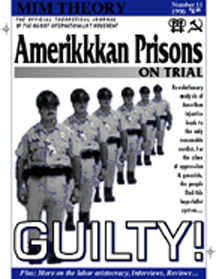
Review: Amerikkkan Prisons on Trial - Guilty!

MT 11 is a must-read, not just for the political- and class-conscious prisoner, but for all prisoners as a stepping stone on the road to liberation and sure footing to understanding the exact context of our imprisonment.
Beginning with the essay "Amerikan Fascism & Prisons," MIM lays out the only real fascist aspect in Amerikan society - the Amerikan prison system. This work is indeed of exceptional relevance as MIM points to the economic motivation behind fascism as well as to the white petit-bourgeois element that breathes life into this most barbaric expression of capitalist production and its anti-revolutionary mission statement.
The article "Capital & State Join Hands In Private Prisons" further elaborates on the thesis that fascism is not just alive and well within the Amerikkkan prison system, but that it has been expanding since the 1980s in the private prison phenomenon, which is but the melding of capital and the state in the growing war against the oppressed nations, with the prerequisite and additional benefit of continuing to win over the middle classes to their side by ensuring them an always available form of employment.
"Prison Labor: Profits, Slavery & the State" then explains how the possibility of open slavery can come back full force thru the institution of the prisons as it was once manifested pre-Civil War. This article also speaks of the important political functions the prison system serves repressing in the national liberation movements and the further indoctrination of the labor aristocracy with fascist ideology.
Nothing however drives home the colonial relation between Amerika and the oppressed nations like the articles "Political Prisoners Revisited," "Political Prisoners & the Anti-Imperialist Struggle" and "Who Are the Political Prisoners?"
"Political Prisoners Revisited" is a good example of the Maoist tenet of unity-criticism-unity in which MIM explains the basics of their line concerning prisoners in Amerika in a dialogue with the New Afrikan Independence Movement. MIM argues that the term "political prisoners" shouldn't just be reserved for individuals such as Mumia Abu-Jamal or Leonard Peltier, but is more appropriately and powerfully applied to all prisoners. All prisoners currently incarcerated under the dictatorship of the bourgeoisie are rightly so political prisoners because the "laws" that we supposedly broke were laws specifically designed for the backing of the backward illegitimate political agenda of the superstructure and the settler state which it serves. To ignore or refute this point with respect to the entire imprisoned population and instead deflect the political aspect of this oppression to just a few individuals is not just a victory for the bourgeoisie but is itself bourgeois in essence!
"Political Prisoners & the Anti-Imperialist Struggle" centers on the antagonistic contradiction of Amerika vs. the oppressed nations that is reflected thru the prison system. It focuses on the material basis objectively present in the form of the gulag, and the material forces already present therein. MIM discusses the dire need for leadership to further help develop these potentially revolutionary forces to their logical conclusion, or in MIM's words: "to unite all who can be united to smash imperialism and all its tools of oppression..."
MIM understood the process of rapid radicalization of "common criminals" as a profoundly political one and in their agitation they emphasized that process as reflecting the material basis for revolution as does MIM(Prisons) and USW. Unity on this point is therefore essential to re-launching the new prison movement in connection with the national liberation struggles which have been repressed and stagnated by the oppressors with mass incarceration.
Finally, "Who Are the Political Prisoners?" is a New York prisoner's contribution and advancement to the MIM line on political prisoners in which s/he expounds MIM's line in detail and in such a way as to leave no doubt that the growth of the prison system within U.$. borders is not just a boil, but a cancer on the oppressed nation internal semi-colonies that needs to be mercilessly removed!
MT 11 also contains, among other things, an essay on Malcolm X's progressive development, a critique of Gandhi's so-called "non-violence" and pacifist strategy and tactics, as well as some good theoretical works and revolutionary poetry.
For all these reasons combined, MIM Theory 11: Amerikkkan Prisons on Trial gets four out of four red stars.
And so with that i end this review the same way the New York prisoner ended his article:
Death and Destruction to the U.$. Empire!
Birth and Construction to the Prison Revolutionary Movement!








